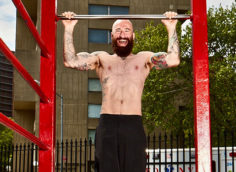Have you ever looked at a truly ripped person – a guy on the cover of a magazine or even the rare local gym specimen – and wondered how you'd look with that kind of leanness?
I have. And I'm thinking about it again.
I've even held that kind of condition on occasion, which may make my craving all the worse. But here's a more important question: Would you like to make a sincere attempt to see, once and for all, how your structure looks at a body fat percentage under six? (Or a body fat percentage under 16 if you're a female?)
Okay, so he needs more muscle, but you get the idea.
We're going to map out a ridiculously simple plan on these pages to get you there. Although simple, there is so much "below the surface" of this plan – hormonally, temporally and metabolically – that it shouldn't be dismissed as too simple.
Notice that I say "simple" rather than "easy". I do so because there's a key element herein that ruins it for most people. All but the most dedicated athletes fail in their fat loss attempts largely for this reason. It's called consistency and it makes all the difference, even in simple, straightforward plans. But fear not, there's a purposeful attention to daily habits in this exercise-and-dietary plan.
Aha! you say. Now it's exercise and diet? Yes, it is. I admit it. So much so, in fact, that the article title is a bit of a misnomer. Maybe I should've called it "100 Slightly Delayed Breakfasts" or something, but, believe it or not, all exercise is really a combination of diet and exercise or vice-versa.
Now that many of you are slightly puzzled regarding the reciprocity of exercise and diet, we'll get back to the simplicity of "100 workouts". Here's the plan and the challenge:
Perform 100 sessions of low-moderate intensity, pre-breakfast cardio, with no more than two days separating any two bouts.
That's it. Really. And I suggest you consider starting NOW, as February kicks off the real fat loss season for those wishing they could be leaner when the weather warms-up and the clothes come off. Let your fat neighbor attempt the muscle wasting, overly intense, last minute cardio in the months of April and May. You're smarter than that. Now, let's take a look at why our early start at a simple, steady meal/ cardio approach will get many of you leaner than ever before, and why some of you unfortunately will fail to lean out by April.
First comes insulin. Did you know that upon waking (especially if you ate a low carb dinner the night before), your fat-protective insulin concentrations are very low – likely to be the lowest of the entire day? (14) This is good, because insulin has very "persistent" protective effects on fat tissue.(5)
Researchers have noted that: "Plasma free fatty acid mobilization is remarkably sensitive to even small increases in plasma insulin."(1) Of course, you'd need to be at least moderately trained to be able to use the mobilized fat,(9) but I'd wager most of us are.
I even do a half dozen bike sprints after lifting on occasion to help ensure my cardiovascular fitness isn't poor. But back to fasting. It's indeed been suggested that a fast longer than any athlete should consider during the day (4-12 hours, the longer the better) is optimal for various aspects of fat loss.(5, 13, 16)
Want to see something cool?


This makes the hour or two before breakfast the best time to perform longer duration, non-panting cardio. Conversely, this is the probably the worst time to attempt muscle-building lifts. One of the strong and valid premises behind "100 Workouts" is the fact that a bodybuilder (per se) should be in radically different hormonal and metabolic states, depending upon which bodily "compartment" is the immediate focus. Muscle building (anabolic exercise) is optimized by high circulating insulin, which we can control dramatically. It's also affected by Testosterone, of course, but this waxes and wanes much more subtly.
Direct fat loss, on the other hand, is tissue-specific catabolic exercise and is best done in the presence of hormones that are often associated with fasting such as growth hormone and maybe even a little cortisol and glucacon – as opposed to insulin.
As with muscle building, the Testosterone relationship to fat loss is secondary in contribution but suffice it to say that it too "rises" in the morning (which should be obvious to us guys), and that's somewhat comforting considering the relative hyper-cortisolemia that's present during the first three hours of waking.
Okay, endocrinology has been briefly handled. On to why some of those who try this "100 Workouts" thing will fail...
You know as well as I do that if there's a golden rule to training, it's consistency. It supersedes just about everything else. Knowing that this is the difference between you and Maggie McButterpants, who shows up next to you on the treadmill in the gym every few months, let's see how we can stick with it.
This really is ultra-important when moderate "cardio" only expends about 200-300 kcal beyond what we'd burn sitting on our duffs for 60 minutes. (Resting metabolism alone amounts to about 1 kcal per kg for men and 0.9 kcal/kg for women each hour.)
First comes schedule hassles. How many times have you heard someone say "I just don't have the time" or maybe "I missed my afternoon workout today because I had to... (fill in the blank)". Although sometimes unavoidable, we can't let this happen regularly.
One way I've seen persons deal with this successfully is to make the time by waking up 60-90 minutes earlier. Yeah right, Lowery. Listen, if you can manage eight hours of sleep most nights (and thus are getting in reasonable amounts), you can at least consider a trial run.
Here's how I've done it in the past:
- Wake to a 5:00 AM alarm and consume a preemptive low-dose stimulant like half a caffeine tab, a half-dose of Spike, or a full scoop of Power Drive.
- Roll over and snooze until 5:45 AM when a secondary alarm signifies it's time to clutch some auto-brewed java and climb onto the treadmill (or go outdoors, weather permitting). Time for that brisk weighted walk or light walk-jog. Invariably, within five minutes of beginning, I'm having very little problem. The intensity is so low that it's hardly a workout for an experienced weightlifter. An X-Vest or books in a backpack may help if jogging is contraindicated or a treadmill is unavailable
- Make sure the pace is non-panting and even consider keeping the fatty areas warm with a loose weight belt. Did you know fat extraction from adipose cells and subsequent muscle uptake/ burning of said fat are related to blood flow?(10, 15) Although often described in the context of capillary density at the muscle (i.e. aerobic training status), one has to wonder how body part-specific warming will contribute. Will a guy's fatty, cool-to-the-touch love handles melt away when clearly very little hot blood is perfusing them during fasted exercise?
- Finish walking by 7:00 AM and have a nice low-glycemic (e.g. steel cut oats and berries) breakfast with adequate protein (I like 30-40 grams mixed into my oats). This type of workout/ meal combination actually enhances muscle glycogen balance while setting the stage for negative fat balance.(16)
That's right; there's no reason to fret over carb-depleted fast twitch fibers – you know, the ones that'll be moving the big weights come afternoon. (3) And it's worth mentioning that cereal in the morning is related to lower cortisol later in the day (18), or at least less severe nasal infections when they hit.(17) One unusual study even illustrates that cortisol may be more apt to fall after morning meals versus later ones.(7) This is good news since we just had some cortisol-elevating java at a time of day when cortisol is naturally high.
- Simply lift later in the day per usual, being sure to keep up the peri-workout carbs (pre-, mid-, and post-exercise), as we men may need more than usual, once we've done the light AM cardio thing. And as a bonus, we may experience increased vasodilation and lower stress hormone responses, including cortisol, when we do train later on.(6)
Secondly we have to consider habit formation. There seem to be two types of people here: those who can follow an intermittent schedule, and those who need to perform a habit every single day to reinforce it. I'm not a psychologist and this is by no means a scientific description but both types do exist.
In fact, one of the best exercise analogies I've heard is that "exercise is like personal hygiene". It's something that is simply necessary each day. Of course, some guys don't shower or brush or wear deodorant daily either! In any case, it's a good way to look at it.
We should also consider making the light-moderate cardio as pleasurable as possible. A truly dreadful 60 minutes spent staring at the paneling in one's basement might just shut down the whole 100 Workouts effort after a week or two.
Let's be frank. Wall-watching is indeed pure suckage – at least to most people. Here, then, are a few tricks I've used:
- Place a board across the treadmill uprights with a wireless laptop on it; web-surfing really helps.
- Again do the laptop thing but check your email or do your homework; I hate to waste time and this is a remedy.
- Call a friend who's made a pact with you to also lean out in this early manner. When a physically-present cardio partner is impossible, a phone conversation can still pass the time.
- Got a laptop with an impossibly tiny screen? Audio is an alternative. Headphones with favorite music can be as effective as a dietary stimulant if you're anything like me. A key here may be to put them on as soon as you're vertical.
- Is the weather dry and the sidewalk non-icy? Getting outdoors is actually a better calorie drain anyway. If you're super-Type A like me, you might even dictate audio "to do notes" into a recorder for the day. Remember, you're not panting so it's do-able.
- Lastly, don't deal with dry mouth or hypoglycemic feelings. Sipping non-sweet coffee, tea, water or even a sports drink after exercise has begun (say, 10 minutes-in if it's carb-containing) will keep you hydrated and the carbs won't raise insulin levels if you're moving at a reasonable pace.(11) Common sense regarding weakness, dizziness, shaking and sweating or other such low-blood sugar sensations is necessary. Drink some carbs and get off the treadmill if need be. Talk to your physician if you think you're having unusual responses to exercise.
Now briefly back to nutrition. For those concerned about waking cortisol – or for basically anyone who has gotten-in 20-25 of these pre-breakfast aerobic sessions – we do have an alternative to all-out fasting.
In the past I personally think that I've benefited from just a quarter-scoop (~1 Tbsp) of protein powder, an egg white or even 3-5g of glutamine or indispensable amino acids just as I'm beginning the "cardio".
As stated, since insulin is one focus here, one might even wait until 10 minutes of the "cardio" have passed. This is a tweak, however, and depends in part on one's somatotype (ectomorphic vs. mesomorphic or endomorphic), his training status, and his personal observations/ experimentation over a month.
One might even consider a small amount of very low-glycemic carbs just beforehand with his java, as some evidence (2, 19) suggests that the insulin response and/or blunting of fat oxidation (RER) is small enough to be intermediate between fast-acting carbs (which would be bad here) and water (which provides no insulin response, per se).
So there you go. Some of you may recognize the gods of exercise physiology among these references. The data aren't new but they are rock solid. Although there's certainly different ways to skin a cat (or rather make yourself look a bit more "skinned"), this particular approach is a direct attack on body fat that importantly does not fatigue most people, drain muscle glycogen, or worsen overtraining risk.
Plus, the biochemistry of direct fat loss is compelling, regardless of what you may see about the equality of divided small cardio sessions throughout the day. (Again, different ways to skin cats... )
While my academic snobbery and cautious consumer advocacy has for years prevented me from doling-out diet plans or exercise plans, "100 Workouts" is as close as I've ever gotten.
You can see, however, that there's still a focus on daily habits and long term success, even though this exploration is mostly meant as a "target date" type of diet – or perhaps a metabolic kick off, as it were, to a future of improved overall leanness. Let's conclude with the benefits of what we've discussed in this article:
- Improved lipolysis (fat breakdown) and direct fat oxidation (fat burning).
- A rate of fat loss that's satisfying to any intelligent and experienced person (about one-half to one pound per week).
- A rate of fat loss that's slow enough (yes, slow enough) to help prevent "metabolic shutdown" (call it starvation mode or thyroid suppression or rebound risk or leptin reduction or whatever you like – See Restriction Contradiction for more info).
- Little, if any, interference with a person's usual bodybuilding program.
- Regarding point four, little glycogen depletion or exacerbation of stress outside of one's weightlifting period (the latter being inevitable if you train aggressively).
- A simple plan built upon daily habits. Pre-breakfast cardio can be considered as similar to personal hygiene, in fact, something one simply allots time for each day.
- A plan that, if done conscientiously every day, (or with no more than one or two days off between "cardio" sessions, such as Wednesdays and Sundays) will lead to noticeable leanness by summer – and even more leanness as summer progresses.
References and further reading
- Coyle, E. Fat metabolism and exercise. Sports Sci Exchange. 59: 1-7.
- DeMarco, H., et al. Pre-exercise carbohydrate meals: application of glycemic index. Med Sci Sports Exerc. 1999 Jan;31(1):164-70.
- Fairchild, T., et al. Glycogen synthesis in muscle fibers during active recovery from intense exercise. Med Sci Sports Exerc. 2003 Apr;35(4):595-602.
- Felig, P. and Wahren, J. Fuel homeostasis in exercise. N Engl J Med. 1975 Nov 20;293(21):1078-84.
- Flynn, M., et al. Effects of 4- and 8-h preexercise feedings on substrate use and performance. J Appl Physiol. 1989 Nov;67(5):2066-71.
- Galassetti, P., et al. Effect of morning exercise on counterregulatory responses to subsequent, afternoon exercise. J Appl Physiol. 2001 Jul;91(1):91-9.
- Holmback, U., et al. Endocrine responses to nocturnal eating – possible implications for night work. Eur J Nutr. 2003 Apr;42(2):75-83.
- Kanaley, J., et al. Cortisol and growth hormone responses to exercise at different times of day. J Clin Endocrinol Metab. 2001 Jun;86(6):2881-9.
- Kanaley, J., et al Fatty acid kinetic responses to running above or below lactate threshold. J Appl Physiol. 1995 Aug;79(2):439-47.
- Lambert, E., et al. Nutritional strategies for promoting fat utilization and delaying the onset of fatigue during prolonged exercise. J Sports Sci. 1997 Jun;15(3):315-24.
- Luyckx, A., et al. Effect of glucose on plasma glucagon and free fatty acids during prolonged exercise. Eur J Appl Physiol Occup Physiol. 1978 Jul 17;39(1):53-61.
- Massicotte, D., et al. Metabolic response to [13C]glucose and [13C]fructose ingestion during exercise. J Appl Physiol. 1986 Sep;61(3):1180-4.
- Montain, S., et al. Exercise metabolism at different time intervals after a meal. J Appl Physiol. 1991 Feb;70(2):882-8.
- Robertson, M., et al. Extended effects of evening meal carbohydrate-to-fat ratio on fasting and postprandial substrate metabolism. Am J Clin Nutr. 2002 Mar;75(3):505-10.
- Saltin, B. and Astrand, P. Free fatty acids and exercise. Am J Clin Nutr. 1993 May;57(5 Suppl):752S-757S.
- Schneiter, P., et al. Effect of physical exercise on glycogen turnover and net substrate utilization according to the nutritional state. Am J Physiol. 1995 Dec;269(6 Pt 1):E1031-6.
- Smith, A. Stress, breakfast cereal consumption and objective signs of upper respiratory tract illnesses. Nutr Neurosci. 2002 Apr;5(2):145-8.
- Smith, A. Stress, breakfast cereal consumption and cortisol. Nutr Neurosci. 2002 Apr;5(2):141-4.
- Thomas, D., et al. Carbohydrate feeding before exercise: effect of glycemic index. Int J Sports Med. 1991 Apr;12(2):180-6.





